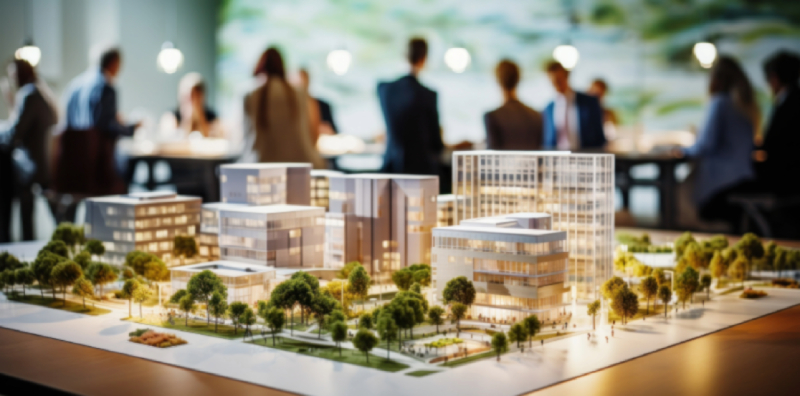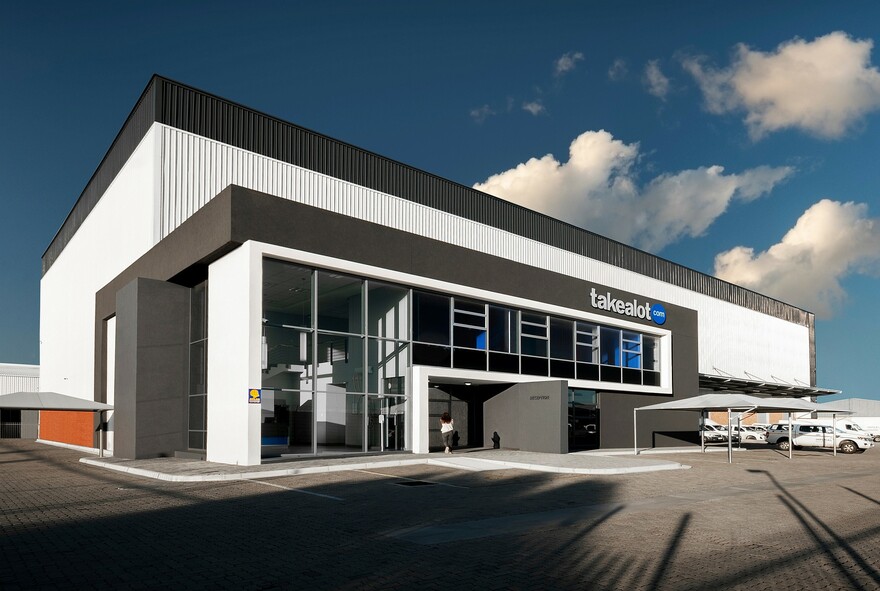Exactly How Commercial Architects Can Change Your Organization Room With Expert Style Providers
Commercial architects play a necessary role in reshaping organization environments. Their knowledge in style can substantially improve both functionality and aesthetics. By developing areas that show a brand name's identity, they boost operational effectiveness and staff member complete satisfaction. The impact of their work prolongs beyond mere look. Understanding the subtleties of cooperation and sustainability can bring about transformative results. What details aspects make these transformations successful?
Comprehending the Function of Commercial Architects
Commercial architects play an important function in forming service settings that are both functional and cosmetically pleasing. They focus on making spaces customized to the particular requirements of services, guaranteeing that every square foot is utilized effectively. These experts incorporate aspects such as spatial layout, lights, and products to boost productivity and worker wellness. By collaborating with clients, business architects collect insights into functional demands and brand identification, converting these into ingenious designs.Additionally, they browse intricate building ordinance and zoning laws, ensuring conformity while making best use of style capacity. Their competence includes sustainability techniques, promoting power effectiveness and eco-friendly materials in their projects. With their innovative vision and technical knowledge, industrial architects not only develop appealing areas yet also foster atmospheres that advertise partnership and growth. Ultimately, their contributions considerably impact the overall success and picture of a company.
Benefits of Expert Style Providers

Tailoring Rooms to Your Brand Identity
Tailoring rooms to a brand's identification is important for conveying its core worths and objective. Commercial architects play a crucial duty in enhancing a business's visual identity via thoughtful layout options. By straightening architectural components with brand name concepts, companies can develop environments that reverberate with customers and staff members alike.
Reflecting Brand Worths
Just how can a well-designed space embody a company's core values? Commercial architects play a critical role in shaping environments that resonate with a brand name's identity. By incorporating aspects such as color plans, materials, and formats, they produce rooms that reflect the significance of the business. For example, a tech business may choose open designs and contemporary furnishings to communicate development and collaboration, while a luxury brand might choose sophisticated surfaces and intimate spaces to evoke exclusivity and refinement. Thoughtful style not only enhances functionality yet additionally cultivates a strong connection in between employees, clients, and the brand name. Ultimately, a well-crafted setting offers as a tangible representation of a firm's goal and vision, reinforcing its worths at every touchpoint.
Enhancing Visual Identity
What aspects can properly elevate a brand's aesthetic identity within a business area? Commercial architects play an essential duty in integrating style attributes that resonate with a company's ethos. Color pattern, typography, and materials can be tactically chosen to show brand name values while guaranteeing aesthetic allure. Furthermore, including logos and brand name imagery right into the design can produce a cohesive aesthetic narrative. Lighting style can better enhance the environment, guiding consumer understandings and experiences (commercial architects). Format and furnishings choices should straighten with the brand name's individuality, whether it's contemporary, traditional, or ingenious. Inevitably, a properly designed business room not only draws in customers however also reinforces brand name acknowledgment, producing a long-term impression that fosters commitment and involvement
Enhancing Capability and Efficiency
Enhancing performance and performance in commercial areas entails enhancing space application and developing workflows that streamline procedures. Architects concentrate on developing designs that decrease squandered area while promoting smooth modifications in between tasks. This approach not only boosts productivity however also contributes to a much more natural functioning setting.
Maximizing Room Utilization
Effective room use is an essential consider industrial style, where the design must balance aesthetics with functionality (commercial architects). Architects employ different methods to optimize offered square footage while making sure that each area offers a distinct function. By find out here now assessing operations, website traffic patterns, and customer requirements, architects can develop designs that improve both staff member productivity and customer experience. Multi-functional areas, versatile furniture arrangements, and maximized storage space services are important elements in accomplishing this this article goal. In addition, incorporating natural light and open spaces fosters an extra welcoming ambience, more elevating the utility of the atmosphere. Inevitably, reliable space use not only enhances operational performance but also adds favorably to the overall brand name picture, making it a crucial factor to consider in business design
Structured Operations Layout
Exactly how can a well-designed workflow transform an industrial area into a center of performance? Structured process layout concentrates on maximizing the physical format and operational procedures within a company atmosphere. By tactically preparing workstations, meeting areas, and sources, architects can remove unneeded motion and enhance partnership. This thoughtful style lessens interruptions and assists in interaction, enabling workers to concentrate on their jobs a lot more successfully. In addition, incorporating innovation right into the process can additionally automate processes, lowering time spent on regular jobs. Therefore, companies experience boosted employee spirits and enhanced outcome, developing a vibrant ambience that fosters innovation. Inevitably, investing in streamlined workflow design not only boosts capability yet additionally positions an industrial space for sustainable development and success.
Cultivating Collaboration Via Design
Although modern workspaces typically focus on specific productivity, the style of commercial rooms increasingly stresses collaboration as a vital chauffeur of advancement and team cohesion. Architects play a vital duty in producing atmospheres that cultivate communication amongst employees. Open up layouts, multifunctional rooms, and tactically placed communal locations urge spontaneous conversations and conceptualizing sessions.Incorporating aspects such as movable furniture and adaptable meeting spaces permits groups to reconfigure spaces based on their joint needs. Furthermore, incorporating innovation, like interactive whiteboards and video conferencing tools, enhances the capacity to communicate efficiently, despite location.Natural light and biophilic style components also contribute to a more welcoming ambience, promoting convenience and wellness, which are essential for productive synergy. By concentrating on these aspects, business try these out architects can create vibrant atmospheres that not only boost collaboration yet also drive overall service success.
Lasting Layout Practices in Commercial Style

Instance Researches: Effective Changes by Commercial Architects
The application of lasting style practices has not only reshaped the technique to commercial design yet has actually likewise resulted in remarkable transformations in numerous business areas. One noteworthy instance is the redesign of a technology business's head office, where architects incorporated natural light and eco-friendly wall surfaces, causing enhanced employee wellness and efficiency. This change reduced power expenses by 30% and improved the firm's public image.In an additional circumstances, a retail shop underwent a complete overhaul, utilizing recovered materials and energy-efficient systems. This not only attracted eco-conscious customers however also enhanced foot website traffic by 25%. A third case involved a business office that welcomed an open-plan layout with adaptable work spaces, cultivating partnership among groups. The architects' concentrate on producing a vibrant and versatile atmosphere considerably boosted employee fulfillment. These case researches exhibit how business architects can develop impactful areas that line up with company objectives and sustainability efforts.
Frequently Asked Questions
Exactly How Much Do Commercial Style Services Commonly Expense?
The cost of business style services differs widely, commonly ranging from $100 to $250 per hour. Elements affecting prices consist of job intricacy, location, and the engineer's experience, making it essential for companies to acquire thorough quotes.
What Sorts Of Services Benefit The Majority Of From Commercial Architects?
Numerous businesses, consisting of retail, hospitality, and company workplaces, substantially gain from business architects. These professionals improve capability, appearances, and brand identity, making sure rooms are enhanced for consumer interaction and worker performance, ultimately cultivating organization development.
For how long Does an Industrial Design Task Normally Take?
The timeline for a commercial layout task normally varies from a number of weeks to numerous months. Factors affecting duration include task complexity, regulatory authorizations, and cooperation among stakeholders, all of which can influence overall conclusion time.
Can I Work With a Commercial Architect for Renovations Only?
Yes, hiring an industrial engineer for remodellings is viable. Numerous architects focus on restoration projects, providing experience in optimizing existing rooms while adhering to guidelines and boosting performance, looks, and total worth of the service environment.
What Qualifications Should I Look for in a Commercial Architect?
